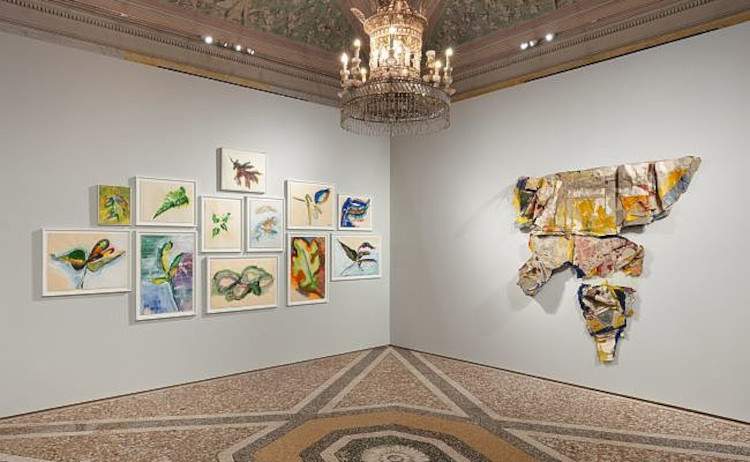GAM in Milan hosts Suzanne Jackson's solo exhibition, the first dedicated to her by a European institution
Somethings in the World is Suzanne Jackson’s solo exhibition, curated by Bruna Roccasalva, promoted by Fondazione Furla and GAM - Galleria d’Arte Moderna di Milano for the fifth edition of the Furla Series program. The exhibition, the first dedicated to the artist by a European institution, is on view at the GAM in Milan from September 15 to December 17, 2023, and aims to offer a glimpse of the research that Suzanne Jackson has been pursuing for more than fifty years and to reconstruct its fundamental nuclei.
The exhibition stems from the idea of retracing and presenting the different moments of Jackson’s production by tracing its recurring elements, from the beginnings to the most recent outcomes, through a selection of the most representative works. A total of twenty-seven works, including iconic, previously unseen works and new productions, are exhibited, with the aim of creating a narrative that accompanies the public within the artist’s world and creating a dialogue with the context of GAM and the works in the permanent collection.
AnAmerican artist whose practice embraces a broad field of inquiry that explores the potential of painting and is nourished by experiences in dance, theater, and poetry, Suzanne Jackson’s intentions, reiterated in the title of the exhibition, figure that her work must first and foremost return her experience “in” the world and “of” the world. In fact, the artist’s entire production is characterized by phases that are closely related to her biographical events and that flow into each other, continuously mixing and blending over the years: a constant interweaving of the private and personal dimension with the artistic and professional one, which the exhibition aims to recount through an exhibition itinerary built not chronologically but by associations and correspondences, to emphasize links and continuous cross-references between themes, techniques and languages.
To thelove of nature, which runs through all the artist’s work, the second room is dedicated with a wide selection of unpublished works on paper that have leaves as their only protagonists (from the series Idyllwild leaves, 1982-84). Alongside these, an iconic work such as Triplical Communications (1969), speaks of the interconnectedness of the spirit, the human and nature, while Somethings in the world (2011), a large-scale work exhibited here for the first time, demonstrates how the artist’s love of nature also translates into a constant focus on recycling and reuse of salvaged materials, including Bogus paper, a discarded paper salvaged from theater sets. The use of various types of paper, rare and common, as an alternative medium to canvas marks the beginning of an investigation into the structural possibilities of painting that will take Jackson’s work in unpredictable directions. In the next room, the monumental triptych In A Black Man’s Garden (1973) exemplifies the production of the 1970s in which Jackson, using an acrylic painting technique similar to watercolor, restores the beauty of nature through all its elements. The forms seem to float on the surface of the canvas thanks to a chalk-white background, which characterizes the pictorial production of this period in which the images are obtained by the progressive application of glazes of color that give them an evanescent texture and reveal the long process of working and reworking. The juxtaposition of this painting with two later works such as Joan’s Wind (1997) and The white-eyes shift (2022) clarifies the extremes between which the artist’s painterly research and multiple experiments with the material he feeds on move.
The exhibition tour continues in the fourth room devoted to themore sculptural aspect of Jackson’s work, with recent works such as Red Top (2021), Quick Jack Slide (2021) and the previously unseen Future forest (2023), created for the exhibition. Closing the exhibition are the most recent pictorial productions: a series of works that consist of dense layers of pure acrylic that serves as both medium and support, such as Rag-to-Wobble (2020) and the monumental Deepest ocean, what we do not know, we might see? (2021). Using paints that are now opaque and now iridescent and creating variations in thickness and transparency, the artist spreads acrylic in variously thickened layers that generate forms with irregular and organic contours, and cause the paint material to react dynamically to the light passing through it and to the viewer’s movements. Known as anti-canvas, these works have also recently been called environmental abstraction.
For info: http://www.gam-milano.com/
Hours: Tuesday through Sunday 10 a.m. to 5:30 p.m. Closed Mondays.
 |
| GAM in Milan hosts Suzanne Jackson's solo exhibition, the first dedicated to her by a European institution |
Warning: the translation into English of the original Italian article was created using automatic tools. We undertake to review all articles, but we do not guarantee the total absence of inaccuracies in the translation due to the program. You can find the original by clicking on the ITA button. If you find any mistake,please contact us.




























